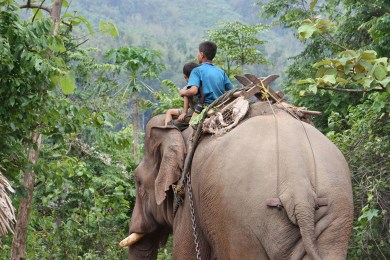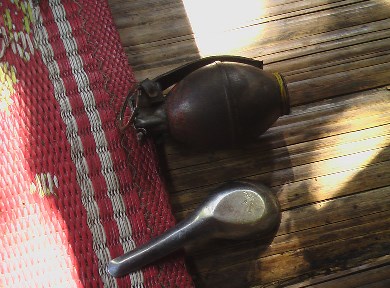One of the most common forms of abuse in Burma has been forced labour, which has direct consequences for families and communities; when parents are forced to work for the military, children are required to compensate for their parents’ loss of work.

Many children in the Karen State try to earn money to support their families by hiring out elephants, for example to carry firewood. (Photo: KHRG)
Sometimes children have even taken their parents’ place in forced labour duties to ensure that their parents could continue to work on their own farms (see KHRG, 2008, pp. 4-5). When regular demands for forced labour have been combined with land and property confiscation as well as arbitrary taxation and restrictions on trade and movement, civilian livelihoods have severely been hampered resulting in deep-seated poverty. Living in poverty, many children in Burma have had to take on labour themselves and are unable to go to school.
Emotional scars of abuse also have far-reaching consequences. Victims of torture for example, carry emotional scars of their experiences that last a lifetime. They commonly experience depression and difficulties in finding employment or restarting their education (KHRG, 2008). While all survivors of torture experience some level of psychological harm from their experience (for further discussion, see ND-Burma, 2012a), exposure to torture also has consequences on the levels of family and community. Family members of the tortured victim must deal with their loved one’s traumatic experience and often feel resentment and mistrust toward the authorities responsible for the abuse. They also experience feelings of guilt and helplessness for being unable to protect or help their family member. These feelings of resentment can affect multiple generations of family members, who may try to cope with this sense of loss of control through self-defeating means such as substance abuse.
It is thought that one of the main reasons for the Burmese authorities’ use of torture and other repeated abuse was to instil fear in the population and to divide communities by creating distrust and suspicion among neighbours, making it difficult for people to form meaningful relationships (ND-Burma, 2012a). Furthermore, singling out village chiefs for torture and other abuse led to a breakdown in social structure as men became unwilling to serve as chiefs and women were increasingly asked to take on these roles (KWO, 2010). This role reversal has seen a recent change in the Karen State where a ceasefire signed in 2012 has led to less direct attacks on civilians, and men have begun to reclaim their roles as village heads (KHRG, 2016a).
Some ethnic nationality communities have experienced human rights abuse for so long that they have developed specific strategies to reduce the effect of violations (see e.g. Davis, Gittleman, Sollom, Richards & Beyrer, 2012; KWO, 2010).
Before the 2012 ceasefire in the Karen State, village chiefs regularly negotiated with army units to reduce demands for forced labour, food or other supplies from the villages. Villages also developed early warning systems so they could hide food and evacuate when Burma Army troops were approaching. Children also learned early the meaning of abuse and how to avoid it, as evidenced by their responses: “If the SPDC comes, we will run and shelter in Thailand and ask the Karen soldiers to go and shoot them” and “if the SPDC comes we will run to Thailand” (interviews between June and July 2007, with children aged 9-12 in the Karen State; KHRG, 2008, p. 138).
As pointed out by ND-Burma (2012a), the long-term effects of systematic and widespread torture and other human rights violations also pose a serious challenge to true national reconciliation. Survivors of torture and other state abuse, the victims’ families, and communities are all mistrustful of authority figures, have deep-seated feelings of resentment against officials, and fear that abuse will continue. Any administration attempting to develop national unity must deal with Burma’s legacy of human rights abuse if it wishes to ensure a society where there is Rule of Law and respect for State institutions.
Updated October 27, 2016
Continue to Specific Human Rights Violations

